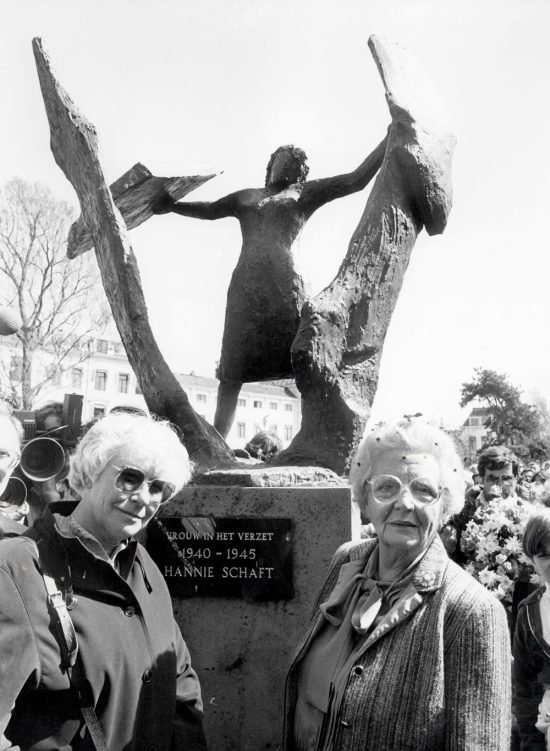Statue "Woman in Resistance" nominated

The municipality of Haarlem’s motivation for the nomination is so compelling that we are happy to reproduce it below:
“A commemoration takes place annually on May 4th at four Haarlem war memorials: the ‘Man before the Firing Squad’ by Mari Andriessen on the Dreef, the ‘Grieving Woman’ by Oswald Wenckebach on the Westergracht, the resistance memorial by Theodoor van Reijn at the Jan Gijzenbrug, and the war memorial in Reinaldapark. There is also one Haarlem war memorial where a well-attended commemoration takes place annually on a date other than May 4th: the beautiful sculpture in Kenaupark, ‘Woman in the Resistance’ by Truus Menger-Oversteegen (1923-2016). This resistance memorial also distinguishes itself from the other Haarlem war memorials by the sculptor: she was active in the Haarlem resistance during the occupation and a companion of Hannie Schaft.
The Haarlem resistance heroine Hannie Schaft was Liquidated by the occupying forces in April 1945 and reburied on November 27, 1945. To commemorate this historic event, the National Hannie Schaft Commemoration Foundation organizes a moving commemoration ceremony at the Groenmarkt Church in Haarlem every year at the end of November. Afterwards, a wreath-laying ceremony takes place in Kenaupark at the statue “Woman in the Resistance.”
The always well-attended commemoration ceremony in November focuses annually on the consequences of exclusion and discrimination and the importance of standing up for freedom in all its aspects. The courageous role played by Hannie Schaft and sisters Truus and Freddie Oversteegen in the resistance aligns with this. Their attitude during the occupation, not turning a blind eye to discrimination and exclusion, serves as an example to younger generations.
The statue 'Woman in the Resistance' is extra special because the sculptor herself was active in the resistance
The sculpture “Woman in the Resistance” is particularly special because the sculptor herself was active in the resistance. During the occupation, Truus Oversteegen, along with her sister Freddie and Hannie Schaft, were members of the Haarlem Council of Resistance, a kind of underground army that didn’t shy away from using weapons. Hannie, Truus, and Freddie were the exception to the rule that applied to these courageous resistance groups. Women or girls rarely played a role in them. Hannie Schaft was over twenty during the occupation, but Truus and Freddie Oversteegen were only sixteen and fourteen years old when they were approached by the Council of Resistance. Girls didn’t easily attract attention and were therefore ideally suited for important courier work, such as distributing illegal printed matter or transporting weapons. The sisters also conducted the preliminary reconnaissance necessary before a sabotage operation could be carried out, transported disguised Jewish children to a safe address, and seduced a German SS officer who was subsequently assassinated by other members of the resistance. What began with distributing pamphlets gradually escalated into the most extreme and rigorous form of resistance: armed resistance, risking their own lives. Fortunately, Truus and Freddie Oversteegen survived the occupation. As is well known, this was not the case for Hannie Schaft. The occupying forces assassinated her in the dunes near Overveen, three weeks before liberation.
After the war, Truus Menger-Oversteegen devoted herself to art. In a 1980 competition, the municipality of Haarlem received more than one hundred designs for a resistance monument in Kenaupark. A jury of artists, former members of the resistance, and a cultural philosopher judged the entries without knowing the names of the entrants. Truus Menger’s design was selected as the winner. Her sculpture expresses the strength of a brave, small woman who dares to stand up to an all-powerful oppressor and overcomes great resistance and dangers. The pedestal reads: Woman in the Resistance / 1940–1945 / Hannie Schaft. Truus Menger dedicated the sculpture not only to her companion Hannie Schaft, but to all women in the resistance. On May 3, 1982, Princess Juliana unveiled the artwork, in the presence of, among others, the sculptor and mayor Jan Reehorst of Haarlem.
Through her artistic oeuvre, but also through her many contacts with younger generations, Truus Menger-Oversteegen continued to take a stand against discrimination and exclusion and advocate for tolerance even after the war. For this reason, Truus and Freddie Oversteegen received the Mobilization War Cross from the Prime Minister in April 2014.
Truus Menger-Oversteegen died on 18 june 2016.”

